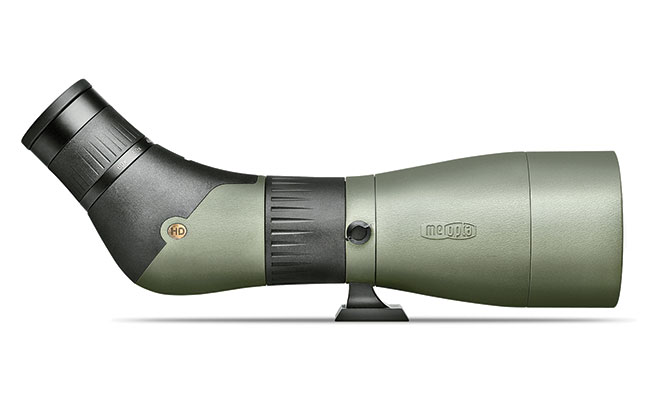POWER
While 20-60X eyepieces sell well, I’ll take a 15-45X, even on scopes with big objective glass. I’ve yet to find a scope underpowered at 45X. It’s more than you need to spot bullet holes in targets.
- RELATED: 29 Must-Have Optics & Sights For 2014
- RELATED: 24 New Optics for 2014
The light weight and compact profiles of 50mm spotting scopes can tempt you, and some of these small scopes, by Burris and others, deliver bright, sharp images in good light. But if you need a spotter for more than an occasional peek, 60mm seems to me a practical minimum. At 15X, you get 4mm of exit pupil, adequate for all but the dimmest of light.
Advertisement — Continue Reading Below
TRAITS
Like cameras, the best spotting scopes have removable lenses. In spotters, they’re the lenses in the eyepiece, straight or angled. For bench work, angled eyepiece models let you peek into the scope with a slight tilt of the head—there’s no need to get out of your shooting position.
TOP SPOTS
Advertisement — Continue Reading Below
Leupold’s Tactical 12-40x60mm Mark 4 has an edge on most of its competitors, with a 5mm exit pupil at the lowest power. I also like the Leupold’s folded light path, which keeps length to a minimum. The scope weighs a modest 37 ounces. You also don’t have to remove its protective soft-sided case to use it. The eyepiece accepts an adapter for digital cameras. (leupold.com; 800-538-7653)
Even more versatile is the new Bushnell Elite Tactical 8-40x60mm, with low-end magnification that matches your binocular. The Bushnell Elite features ED Prime glass and a RainGuard HD coating, with a straight, heavily armored chassis. It has an attractive and distinctive pea-green finish. Like the Leupold, it comes in a heavy black canvas soft case that can be left in place and simply unzipped on the tripod. It weighs about the same as the Mark 4 scope. (bushnell.com; 800-423-3537)
A lightweight option is Alpen’s 15- 45x60mm, which I tested recently with a raft of other spotting scopes. Of traditional design, it features the forward focusing dial I prefer—convenient to reach with my finger as I steady the scope with my hand. Its resolution matches that of much more expensive scopes. (alpenoptics.com; 877-987-8370)
Advertisement — Continue Reading Below
The Meopta 20-70x82mm scope delivers brilliant, needle-sharp images. The insulator came through the glass much more clearly than in the smaller scopes. I’m mightily impressed by this Czech-built scope. Like the Alpen, it has an adjustable collar that lets you rotate the body on the tripod without losing the image. (meoptasportsoptics.com; 800-828-8928)
LAST LOOKS
No matter your choice of spotting scope, insist on fully multi-coated optics. Consider ED (extra-low dispersion) glass, also listed as APO (apochromatic), which corrects for color fringing and delivers the sharpest images. Hunting, you’ll appreciate lenses that shed water. I’m sweet on the split focusing rings on Leica and Zeiss spotters that let you shift effortlessly from fast to fine focusing. You’ll use your binocular constantly, a spotting scope only occasionally. But when you must see far, nothing beats the “big eye.”
Advertisement — Continue Reading Below



























